Meet the State Exec: OAPA’s Larry Patrick
BY AsphaltPro Staff
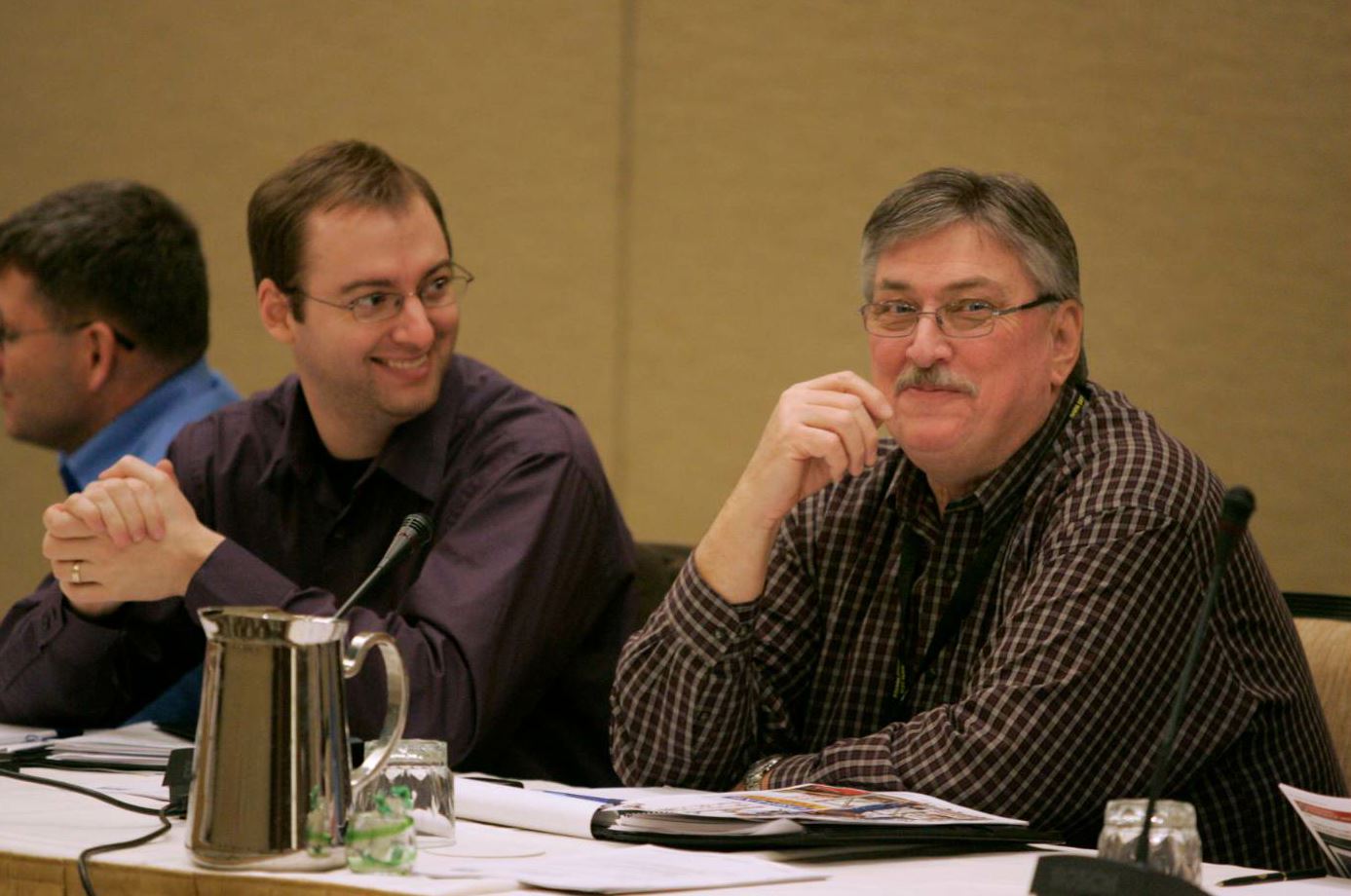
Oklahoma Asphalt Pavement Association, Oklahoma City, was founded in 1971. Now, the association boasts 148 members, including 27 producer members accounting for 95 percent of the asphalt tonnage let to contract in Oklahoma.
OAPA has been led by Executive Director Larry Patrick for the past six years. AsphaltPro spent some time getting to know Patrick and learning about how OAPA is working to promote the asphalt industry in the state of Oklahoma.
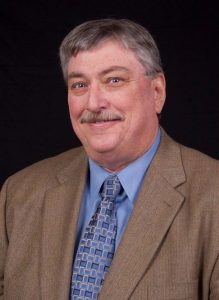 How long have you been in the asphalt industry?
How long have you been in the asphalt industry?
44 years
Do you have a degree related to the industry?
I studied civil engineering at the University of Arkansas. My interest in asphalt actually started in my freshman year at Arkansas. My counselor was Dr. Miller Ford and one of the classes he was teaching was asphalt pavements. I had a meeting with Miller to go over my schedule. Jay Hensley, at the time the Regional Engineer for Asphalt Institute, was sitting in his office. Miller introduced Jay and I, and we started talking. I mentioned to Jay that I was interested in some of the books that Asphalt Institute was publishing. Within a few days, there was a box full of those books sitting in Miller’s office with my name on the box. Not only did this jump start my interest in asphalt but also started a friendship between Jay and I since 1972. I can’t thank Miller Ford or Jay Hensley enough for their friendship, guidance and mentoring all these years.
How long have you been the executive director of your state association?
I started at OAPA April 11, 2011, so it has been 7 years.
How many producer and/or contractor members are in your state association?
The breakdown of our membership is:
Producers: 27
Laydown: 9
Aggregate: 4
Refinery: 7
Consultants: 24
Associates: 50
Governmental: 27
Total: 148
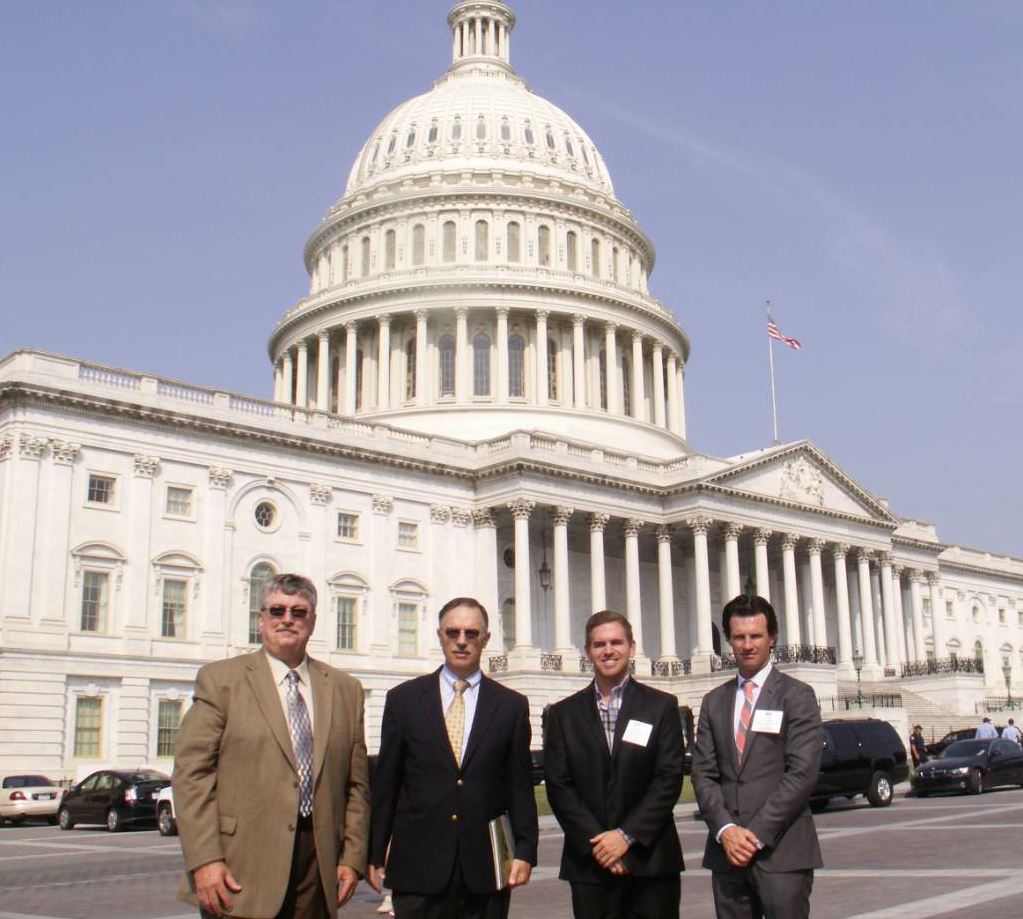
Patrick (left) participates in the 2016 TCC Fly-In with Jay Hansen of NAPA and Aaron Parker and Tim Caudle of Silver Star Construction Co.
What are the top two or three ways you have increased membership in the association?
One thing that has been interesting is how some of our new members have come from project meetings, when issues have occurred. A contracting agency has called for us to do an evaluation on a project, meeting with all parties, and the contractor has seen what we can do. The contractor joins because they see the value of being a part of the association.
We also use our two day annual conference as a stepping stone to association membership. We extend a one-year free membership to a first time attending company. This has lead companies to join and when they see the benefits, they in turn get more involved in OAPA.
Our members are another reason we have such a strong membership. They encourage their suppliers, vendors and companies that perform services for them to be a member of OAPA. We have really concentrated on the consultants. We have reached out to the Oklahoma ACEC to help recruit consulting firms. OAPA has been showing the benefits of asphalt pavements, new technology such as PaveXpress, and just helping troubleshoot to these firms. OAPA encourages the use of our members among our members. This does nothing but strengthens OAPA and its members.
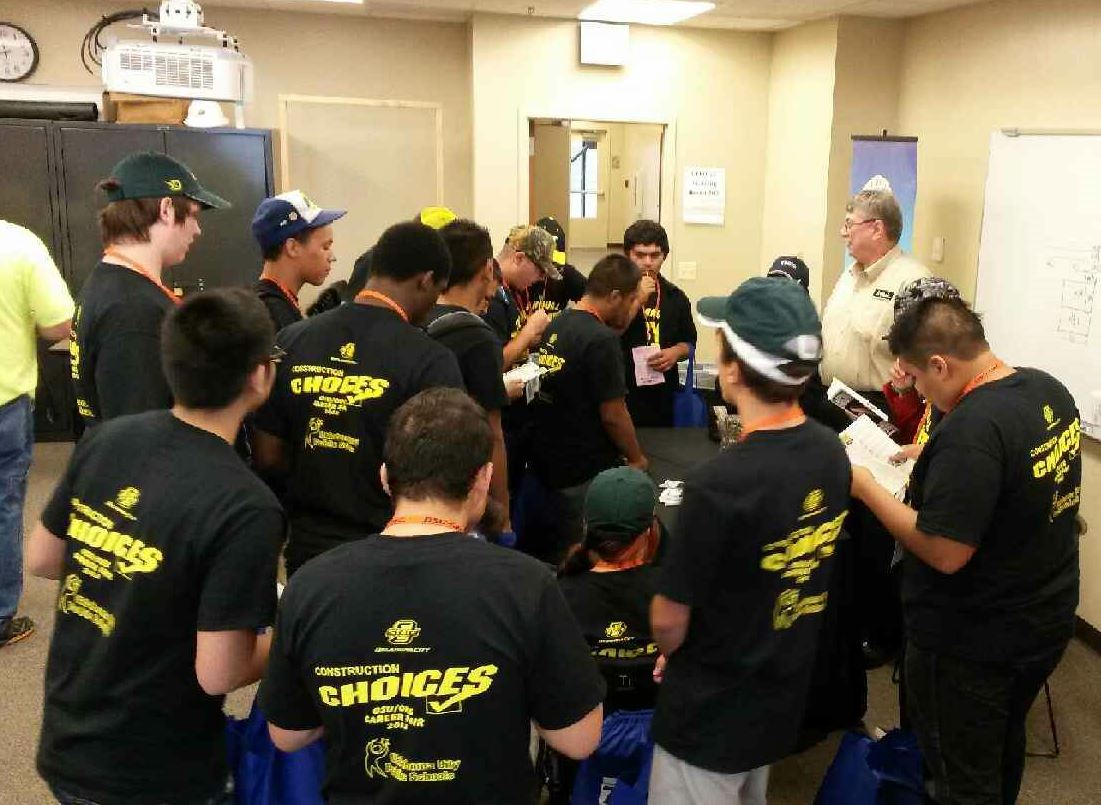
OAPA participates in the Oklahoma City Public Schools Career Day every year by setting up a booth to show what opportunities young people have in the asphalt industry.
What is your favorite method for recruiting new asphalt professionals to the industry in general?
We are doing several things to help bring new folks into the industry. We have a scholarship/internship program with both the University of Oklahoma and Oklahoma State University, where one student for both schools receive $5,000. Of course, with that comes some strings in which they have do 140 hours as an intern with our member companies. In this internship, the student will have to work so many hours with an asphalt plant operation, laydown crew, asphalt cement lab and terminal, mix design lab, pavement design along with so many hours with us here at OAPA.
We also always attend career fairs at both OU and OSU. We are there not only to push the OAPA scholarship/internship program, but also many of the students will leave their resumes with us that we in turn share with our members.
We also participate with the Oklahoma City Public Schools in their career day with many in the construction community. That gives us a chance to show what opportunities there are in the construction field. Not everybody is geared for college and this gives students a chance to see, climb and hear how equipment is used at a construction site. All the companies involved will bring equipment to OSU-OKC where the meeting is held.
In what month do you hold your annual meeting?
April
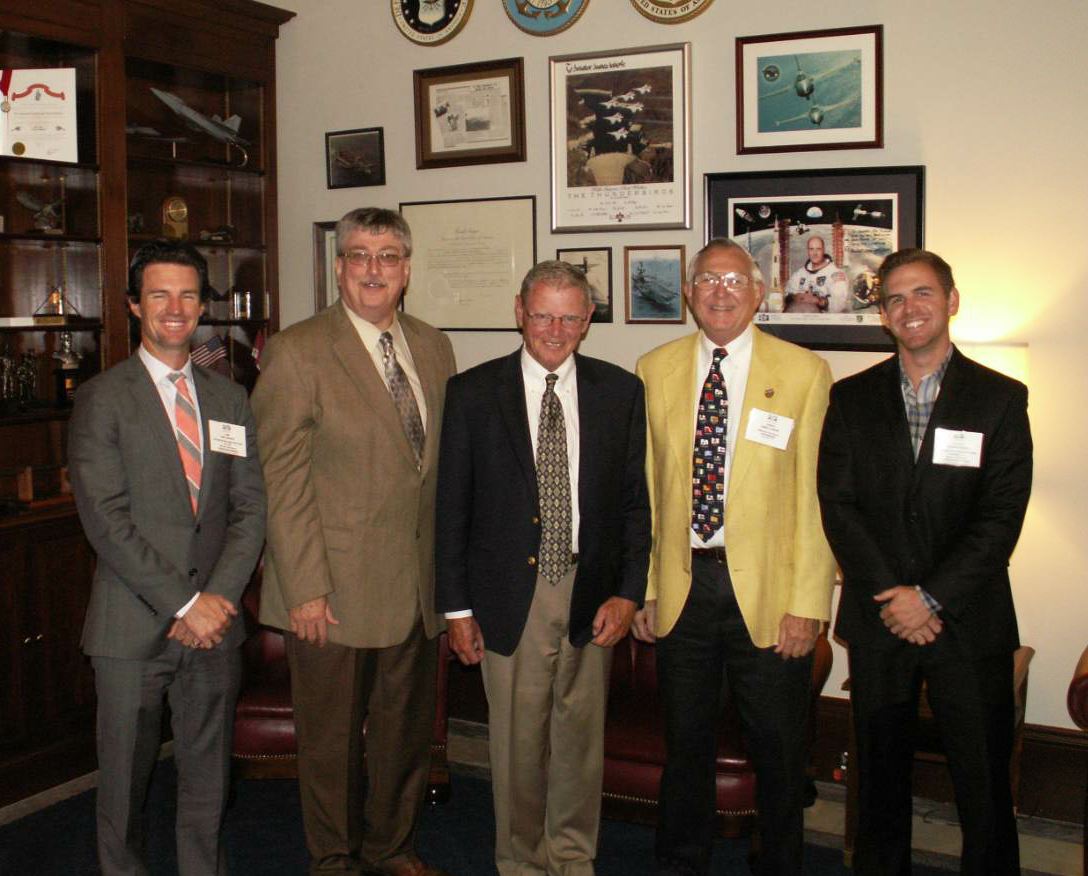
Tim Caudle, Silver Star Construction Co.; Larry Patrick, OAPA Executive Director; Senator Jim Inhofe, Larry Lemon, Haskell Lemon Construction Co.; and Aaron Parker, Silver Star Construction Co.
Do you have a trade show or expo in addition to your annual meeting?
We have an annual conference at the end of February each year. This is a two day conference in which we focus on technical issues with breakout sessions geared towards construction, engineering and safety. The conference has grown from a one-day session with about 170 attendees to the two-day session with last year’s attendance topping out at 450 people. We also have an exhibit hall for companies to display their services and equipment. We also have our awards luncheon on the first day. This gives OAPA the opportunity to honor the previous year’s pavement award winners.
We also have an annual golf tournament, which we split from year to year between Oklahoma City and Tulsa. Not only do our members attend, but also many folks from contracting agencies will come and play. This has been a great networking tool between membership and the contracting agencies.
At our annual meeting in April, on the last night, after dinner we have a live auction in which our members will donate items. This is probably one of the most fun things I have witnessed with our members.
Do you have a staff that assists in preparing the annual meeting?
OAPA has a staff of two: Communication Director Nicole Smith and Administrative Assistant Chante Kizer. These two people are not only my right arm, but my left arm too. I cannot say enough on how they help and actually take care of things not only with our meeting and conference but just in running OAPA.
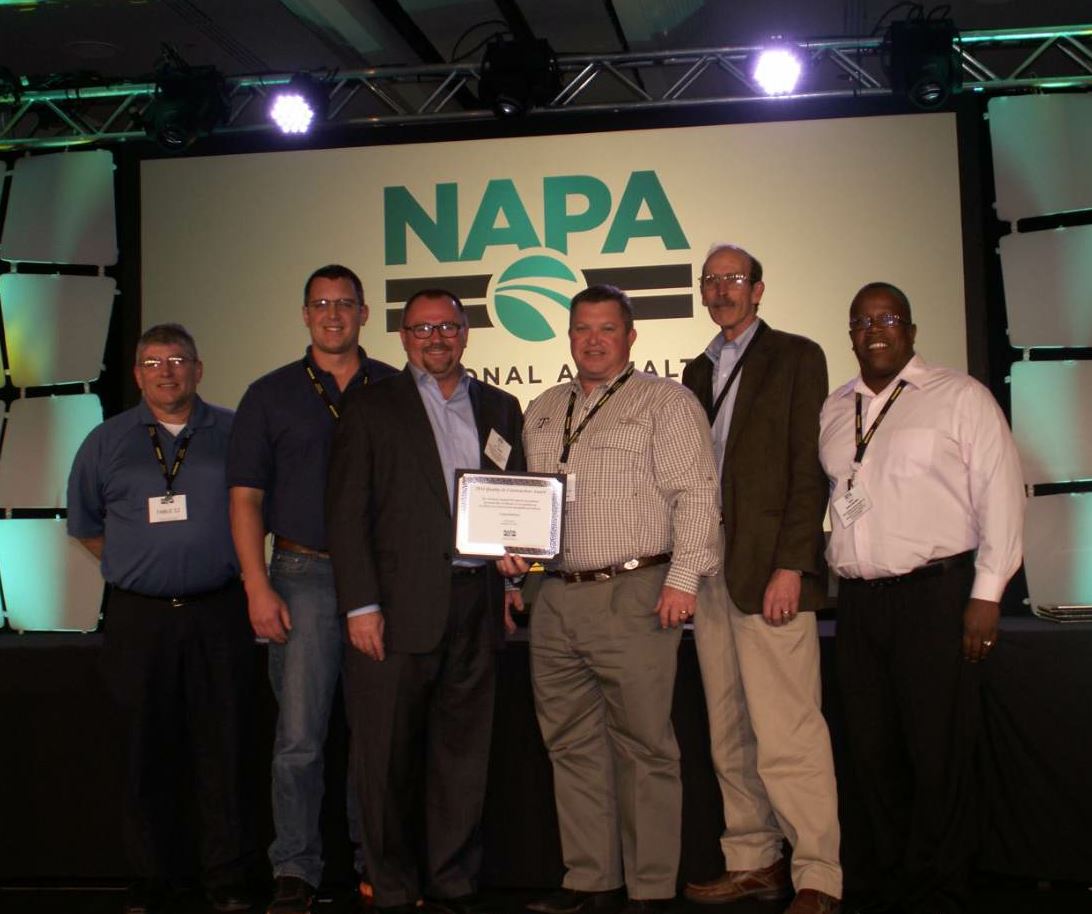
Does your staff hold educational seminars or webinars for members separate from the annual meeting and conventions throughout the year?
OAPA has been involved in a series of lunch-and-learns and workshops with the city of Oklahoma City, several of the Tribal Road Programs, Local Technical Assistance Programs as well with some of the Oklahoma Department of Transportation field divisions. We are also available anytime to our members to have workshops with their employees and operations. Staff is always there to help with registration, getting sponsors and setting the meeting space for these meetings.
About how many member asphalt projects do you visit per year?
Right now, I am spending about 50 percent of my time in the office with the rest being out in the field. During the time in the field, I am going to projects or plants. Sometimes it involves me going to a Field Division, just visiting to see what issues or troubles they are seeing.
About how many member asphalt plant tours are you a part of per year?
When we visit with both the Senators and members of Congress in Washington D.C. and at the State Capitol, we always make sure to invite them to tour a plant or project visit. About once a year, one or two of their staff will take a tour.
About how many member asphalt open house events do you attend per year?
About one a year. One thing that has occurred since I have been at OAPA, is when ODOT Field Divisions are having an open house or employee event, OAPA has been receiving invites from the Division Engineers.
About how many state agency or DOT meetings do you attend per year?
OAPA has a very close relationship with ODOT, Oklahoma Turnpike Authority (OTA), and many cities and counties. I have lost track of how many times we meet, which is a good thing, whether officially or unofficially. They know all they have to do is call; I will meet with them wherever they need me too. I also appreciate the door swings both ways.

OAPA awarded the NAPA Quality in Construction Award to ODOT at this ODOT Commissioner Meeting. Pictured from left: Ken Wert, Haskell Lemon Construction Co.; Larry Patrick, OAPA Executive Director; Greg Love, ODOT Commissioner; Dan Overland, ODOT Commissioner; Paul Rachel, ODOT Division 3 Engineer (retired); Jay Lemon, Haskell Lemon Construction Co.; and Paul Green, ODOT Director of Operations.
On a scale of 1 to 5 (1 being none at all; 5 being very much), how much of a threat to your members’ marketshare/livelihood is the concrete industry in your state?
I would say three and a half to four. Oklahoma has a history of 80 percent asphalt to 20 percent concrete. Of course, this has fluctuated over time from 78/22 or as high as 90/10 asphalt to concrete but has been, for the most part, 80/20.
Could you share an example/anecdote of a time when the concrete industry encroached on the asphalt marketplace in your state?
There is a 20-mile section of a turnpike which was originally built as an asphalt pavement back in 1952. It has performed outstandingly for 65 years with the maintenance measure by OTA. OTA has a program called Driving Forward which is an expansion program for the turnpike system. A 20-mile section of this turnpike is being expanded from four lanes to six lanes. Alternate designs were looked at with LCCA being run on both pavements types. The pavement designers came back with the LCCA showing asphalt would save money but also, with phasing, would save in user costs. It ultimately went concrete. The good news is we are hearing of asphalt perpetual pavements coming out of design that are either new alignment or replacing concrete sections, in which OAPA has been a part of the design strategy.
On a scale of 1 to 5 (1 being none at all; 5 being very much), how much difficulty are your members having in finding qualified workers for their asphalt paving or production crews?
I would say four. Oklahoma’s economy has been geared towards the production of oil and gas. Right now, we are seeing an increase in drilling with horizontal drilling into the shale plays. When we see the increase in drilling, the construction field is the one that suffers. These workers flock to the oil patch because of the higher pay, even though the oil patch is cyclic in nature. As the oil field slows we see these workers come back to construction, but they are always waiting for the next discovery and drilling gets hot and heavy.
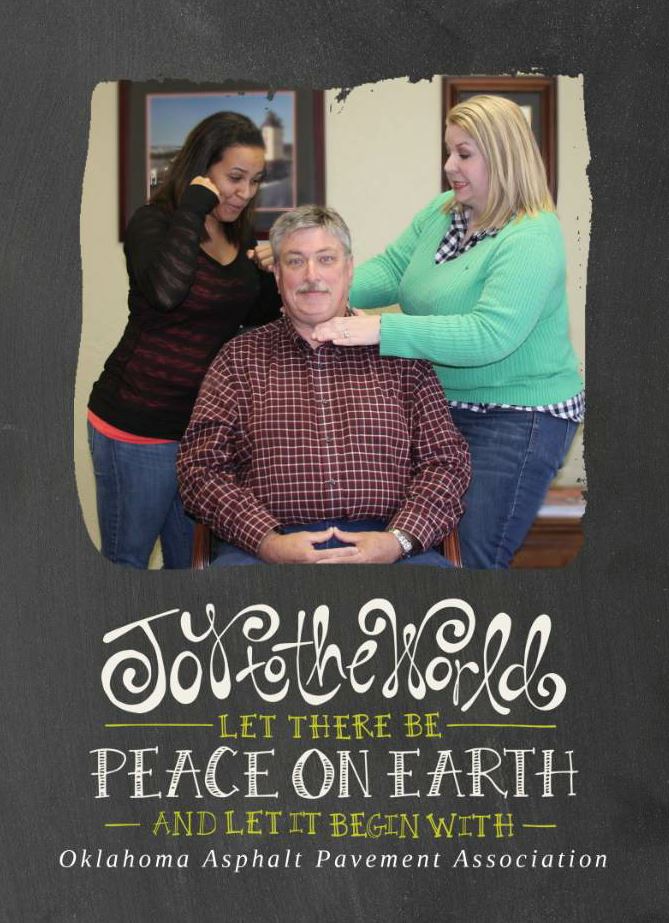
OAPA employees Chante Kizer, left, and Nicole Smith partake in some holiday ‘cheer’ with Patrick for OAPA’s holiday card.
Could you give an example of a way your state APA assists members with workforce development?
OAPA has the Oklahoma Asphalt Quality Initiative. OAQI is an initiative our membership took on, not by any outside entity pressure. It’s just our industry stepping up to the plate to improve our quality. Basically, this requires producer/laydown members to perform an assessment of their operation by the completion of a checklist. Once completed, I will go in and do the same evaluation with my own checklist. Once scored, I will sit down with upper management to go over areas of improvement and training needed. This may be as simple as spending time with the crews or bringing someone in to help with some training from a national level.
If a member calls me at any time to ask me to do some training, we make sure to work with their schedule to get it done.
On a scale of 1 to 5 (1 being none at all; 5 being very much), how involved are your state elected officials in transportation issues such as funding and infrastructure improvements?
Three. We are very lucky in Oklahoma. Our delegation in D.C. understands and “gets it” how important transportation is to Oklahoma. Oklahoma is a major crossroad for moving goods and services across the U.S. with I-40, I-35 and I-44 all intersecting here. That’s not even talking about the secondary roads coming out of Texas. As for the Oklahoma legislative efforts, this past legislative session, they were very protective of the funds for transportation. As a result, ODOT will have full funding for fiscal 2019.
On a scale of 1 to 5 (1 being none at all; 5 being very much), how involved are your asphalt members in transportation issues such as funding and infrastructure improvements?
Three and a half. Like I said, our delegation gets it. We always go to the TCC Fly-In and see the folks on the state side. We also team up with Oklahoma ACPA and Oklahoma AGC when it comes to funding. We can set our differences aside because if the funding is not there, it won’t matter what pavement type.
Could you share an example of a time when your state APA hosted elected officials to educate them on the need for highway funding, asphalt materials, construction workforce development, etc.?
Best example was when Senator Jim Inhofe took a tour of a plant and quarry in Tulsa, Oklahoma. At the time, he was the Chair of the Senate EPW committee. He did not realize the hurdles a contractor has to go through to build a heavy highway construction project. One of his questions was about the workforce. He was asking what the number of employees back five years ago and what was it now. When the host said 500 five years ago and now 325, it caught the Senator by surprise. He wanted to know why, of course and what could be done to increase the numbers of workers. The host said, more funding. We explained to the Senator, the companies as well as other contractors in Oklahoma were only working to about 25% to 30% capacity. If the funding was there, we could do more. He took that example back to Washington.
Get to Know Larry Patrick

Patrick and his wife, Gayla, are avid fishermen. “We love being on the water every chance we get,” Patrick said.
Why did you join the asphalt industry?
Like I said earlier, my interest was started with meeting and developing a relationship with Jay Hensley. Then one summer, I had an internship with the Arkansas Highway Department, now ArDOT, working in an asphalt lab and a plant location in Northwest Arkansas. I was testing mix, aggregates and soils. I was hooked after that. I could not get enough and after 44 years, and I still don’t get enough. It is still fun and I am still learning.
What do you see as the most important part of your job as an executive director of a SAPA?
The most important part of my job is spreading “the gospel” of how good of a product we produce. We have a product that is sustainable, durable, offers an ease of construction and most of all, it’s smooth. I if can promote the previous ideas to contracting agencies and most importantly, the driving public, that frees our members to build and manage their businesses while building the best roads for Oklahoma.
What do you find most enjoyable about your job as an executive director of a SAPA?
It would have to be the relationships, not only with our members but contracting agencies, academia, NAPA, APA and of course SAPA.
What has been the most rewarding experience for you during your time as the executive director?
It’s two fold. One is to see OAPA grow and strengthen. I have been working in highway construction in Oklahoma since 1983 and right now OAPA is stronger than I have ever seen since I have been in the industry.
Secondly, one of the best marketing tools, as I learned when working in the consultant world, is becoming the “trusted advisor.” That is the position OAPA is at. It is a great feeling to have contracting agencies and members reaching out to OAPA to answer their questions.
